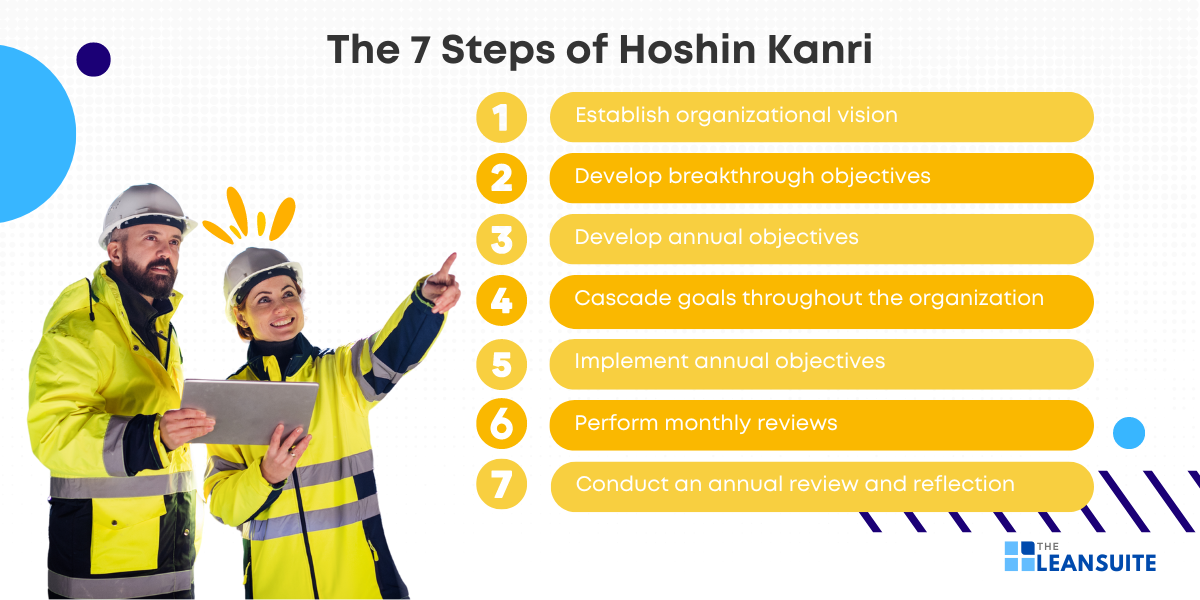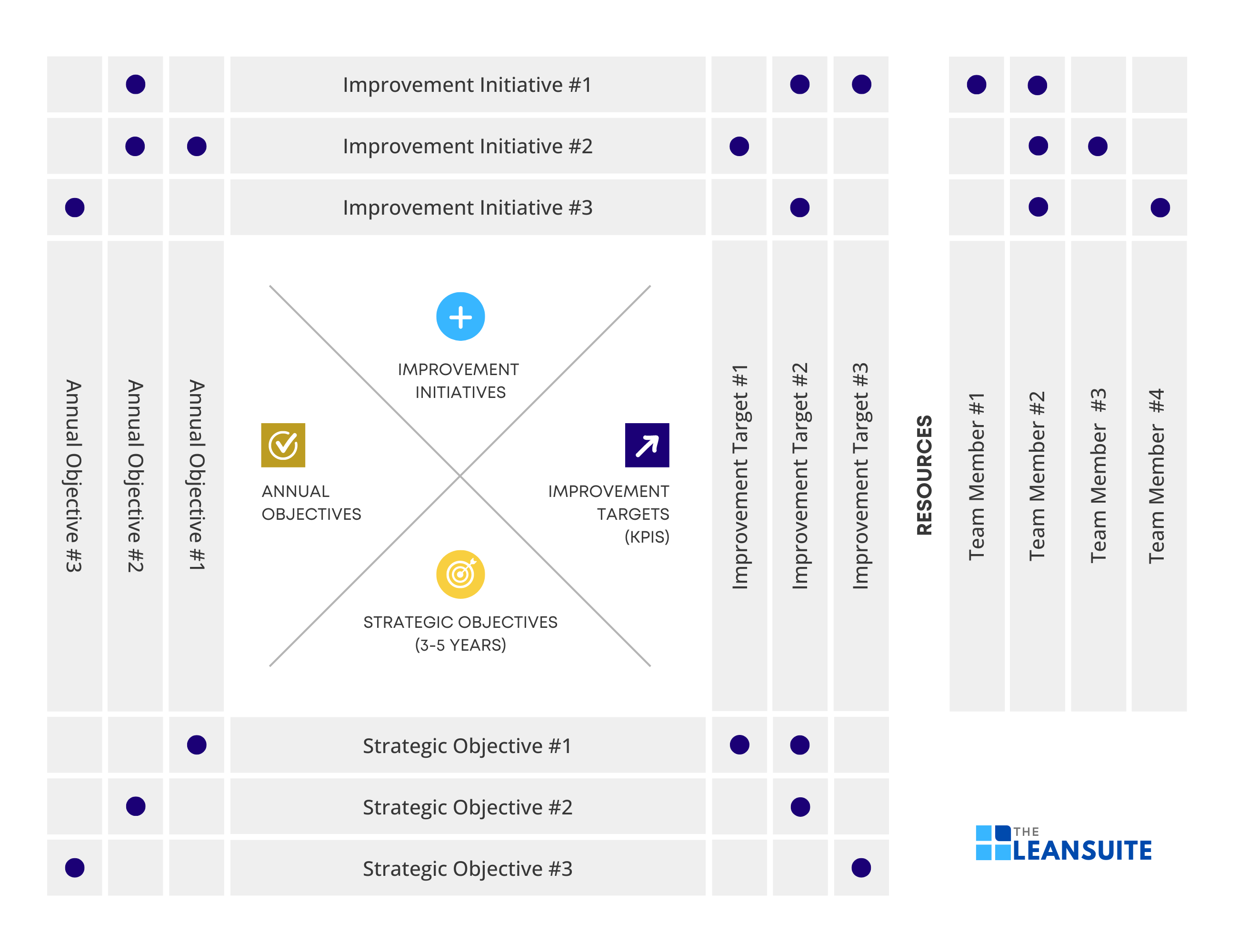5 Imagine steering a ship through uncharted waters, guided only by the stars and a clear vision of your destination—this is the essence of Hoshin Kanri. Originating from Japanese business practices, Hoshin Kanri is a strategic planning methodology designed to align an organization’s functions and activities with its long-term goals. In this blog post, we will explore the 7 steps of Hoshin Kanri so that you can successfully implement it.
What is Hoshin Kanri?
Hoshin Kanri, often referred to as “Policy Deployment” or “Hoshin Planning,” is a Japanese management method designed to help organizations effectively implement their strategic objectives.
Originating from the Japanese term “Hoshin,” meaning “direction,” and “Kanri,” meaning “management,” this method ensures that every member of the organization is aligned with the company’s overall goals. Essentially, by creating a clear and concise strategic plan, the hoshin planning process facilitates the translation of high-level objectives into actionable tasks that employees at all levels can comprehend and execute.
One of the unique aspects of Hoshin Kanri is its integrative approach that combines top-down directives with bottom-up feedback, drawing from Lean process management principles. Senior leadership sets the vision and long-term goals, which are then broken down into specific, measurable targets. These targets are then communicated throughout the organization, encouraging input and continuous improvement from employees on the front lines. This dual-directional flow ensures that the strategic plan is not only well-understood, but also adaptable. Thus, fostering a culture of engagement and innovation.
In short, by aligning strategic intent with operational execution, Hoshin Kanri helps organizations achieve their goals more efficiently and effectively.
The 7 steps of Hoshin Kanri
Hoshin Kanri is a powerful methodology that aligns an organization’s strategic goals with its day-to-day operations. By ensuring that everyone from top management to frontline employees is working towards the same objectives, Hoshin Kanri can transform the way a company operates.
In this section, we will explore the 7 steps of Hoshin Kanri, providing you with a comprehensive guide to successfully implement this approach and drive your organization towards sustained success.

Step 1: Establish organizational vision
Step 1 of Hoshin Kanri, establishing the organizational vision, is an important foundation for aligning your company’s strategic objectives. Basically, it begins with a clear understanding of the current state in relation to the desired vision. For instance, this includes an honest assessment of your existing business planning processes and execution capabilities. By identifying key areas for improvement, your leaders can prioritize initiatives that will drive the most significant progress.
Communicating this vision effectively to everyone in your company ensures that each team member understands and is inspired by the direction the organization is heading. In addition, it’s essential that the vision statement not only supports your team’s long-term goals, but also seamlessly connects back to your company’s overarching mission statement. Therefore, providing a cohesive framework for all future actions and decisions.
Step 2: Develop breakthrough objectives
Breakthrough objectives are ambitious goals intended to drive significant improvements within your organization over a three to five-year period. These objectives often push your organization to stretch beyond its comfort zone. Thus, embracing new opportunities for growth.
Tools like the four quadrants of growth can help identify these opportunities and outline stretch objectives. Breakthrough objectives might include entering new markets, introducing innovative products, or adopting different service delivery modes, all aimed at propelling your company toward its vision.
Step 3: Develop annual objectives
An essential part of the Hoshin planning process is to define annual objectives. This involves setting specific yearly goals that align with long-term strategic plans. Doing so helps in identifying what must be achieved within a year to progress toward the breakthrough objectives. These goals should be SMART: Specific, Measurable, Achievable, Realistic, and Time-bound. For instance, an annual objective might be to ensure that productivity is improved by 20% within 30 days.
Conducting market research studies can help define product requirements and ensure that annual objectives are aligned with market demands and organizational capabilities. Progress can be effectively measured by establishing defined key performance indicators that align with the organization’s overall mission.
Step 4: Cascade goals throughout the organization
Once you deploy annual objectives, they need to be cascaded down to departmental levels using metrics and business-specific targets. A Hoshin Planning Matrix can capture these objectives and cascading priorities. Tools like value stream mapping can also help to identify improvement opportunities and manage progress.
Remember, it’s essential to assign department, team, and individual objectives that align with the overall mission for the year. This ensures everyone is working towards the same goals and fostering a sense of ownership and accountability at all levels.
Step 5: Implement annual objectives
Implementing annual objectives involves implementing improvements through problem-solving approaches such as Kaizen events, innovation projects, or Lean Six Sigma projects. The SCORE methodology can be used to facilitate team improvements. Continuous improvement strategies, such as the DMAIC model, Kaizen methodology, or the PDCA cycle, can be employed to ensure the effective implementation of annual objectives. Therefore, fostering a culture of continuous improvement.
Step 6: Perform monthly reviews
Monthly reviews are essential to monitor progress toward achieving annual improvement objectives and identifying corrective actions for any lagging areas. This step fosters a culture of accountability and continuous action. Moreover, regular check-ins on each person’s progress toward their goals ensure that forward progress is maintained and any issues are addressed promptly. In essence, monthly reviews help keep your organization on track and focused on its objectives.
Step 7: Conduct an annual review and reflection
At the end of the year, a comprehensive review and reflection on the year’s objectives and progress are conducted. This involves assessing the progress against the stated objectives, identifying any adjustments needed for the next cycle, and determining lessons learned from the previous year. This step is crucial for continuous improvement, as it allows the organization to refine its strategies and set new goals for the coming year. Thereby, creating a continuous cycle of growth and development.
The Hoshin Kanri matrix
The Hoshin Kanri matrix is a powerful tool used for strategic planning and management, providing a graphical representation of a company’s strategy and goals. By clearly illustrating the company’s direction, the Hoshin Kanri matrix helps every employee understand where the journey is headed and why their individual actions are crucial to achieving the overarching goals. This alignment fosters a cohesive work environment where everyone is aware of their role in the larger strategy. Thus, enhancing coordination and ensuring that all efforts are synchronized towards common objectives.
The 5 main sections of a Hoshin Kanri Matrix
The Hoshin Kanri matrix is typically organized into five main sections, laid out in a compass pattern. Here’s a breakdown of each section and what you should focus on:
- Long-term strategic objectives (Southern section): The southern section of the matrix contains the organization’s long-term goals. These are the overarching targets that the company aims to achieve over several years. They set the direction and provide a vision for future success.
- Annual objectives (Western section): Moving to the western section, you’ll find the annual objectives. These are the specific goals set for the current year, aligned with the long-term strategic objectives. They break down the broader vision into manageable, actionable parts that can be tackled within a shorter time frame.
- Improvement initiatives (Northern section): In the northern section, the focus shifts to improvement initiatives. These are the projects and actions that need to be undertaken to achieve the annual objectives. They are essentially the steps or strategies put in place to drive progress.
- Improvement targets or Key Performance Indicators (KPIs) (Eastern section): The eastern section lists the improvement targets or KPIs. These are the measurable outcomes that indicate whether the improvement initiatives are successful. They provide a way to track progress and ensure that the organization is on the right path.
- Resources (Far east section): Finally, on the far eastern side of the matrix, you’ll find the resources section. This part identifies which team members are responsible for each improvement initiative and KPI. It outlines the allocation of resources, ensuring clarity on who is accountable for what.
How to read a Hoshin Kanri matrix

Understanding how to read a Hoshin Kanri matrix may initially seem daunting due to its complex appearance, but it’s actually quite straightforward once you know what to look for.
To read a Hoshin Kanri matrix effectively, start at the bottom (the southern section) and work your way clockwise. This method allows you to understand the long-term goals first, then see how they translate into annual objectives, followed by the specific initiatives and the metrics for measuring success.
In each corner of the matrix, you’ll notice small dots that represent the connections between different initiatives and objectives. These dots help visualize how each part of the plan is interconnected, ensuring that every action taken is aligned with the overall strategy.
Benefits and drawbacks of Hoshin Kanri planning
Hoshin Kanri offers several benefits and drawbacks for organizations.
One key advantage is its ability to help your organization focus and visualize corporate goals. It ensures that every level of your company is aligned with your overarching objectives. Additionally, Hoshin Kanri can integrate agile elements into the planning process. In other words, it breaks up rigid hierarchical structures and fosters a more flexible and responsive work environment.
However, this methodology does have some cons. Hoshin Kanri has the potential to set false or unrealistic goals, which can mislead your organization and waste resources. Furthermore, to fully compensate for its limitations, Hoshin Kanri requires the incorporation of additional methods and tools. As a result, this can add complexity and require significant effort to implement effectively.
Implementing Hoshin Kanri in your organization
Implementing Hoshin Kanri in your organization can be a transformative step towards achieving cohesive and strategic growth.
This method is particularly effective when you’re aiming to implement a company-wide strategy or unify your entire team to achieve the same objective. By ensuring that every team member, from top executives to frontline workers, understands and contributes to the overall goals, Hoshin Kanri fosters a culture of collaboration and focused effort.
However, it’s important to recognize that the implementation of Hoshin Kanri is not a quick or simple process. That is to say, it demands a significant investment of time for both planning and execution. The process begins with defining clear, achievable objectives and then breaking these down into actionable steps.
This comprehensive planning phase involves setting long-term goals, identifying critical success factors, and developing detailed action plans. Moreover, it requires continuous monitoring and adjustment to ensure that the organization stays on track and can respond to any challenges or changes in the market environment.
Despite the initial time commitment, the long-term benefits of Hoshin Kanri—such as improved alignment, enhanced performance, and better resource utilization—make it a worthwhile endeavor for any organization seeking sustained success.


